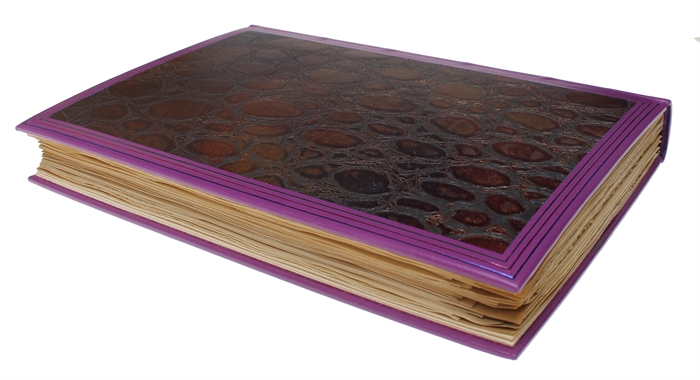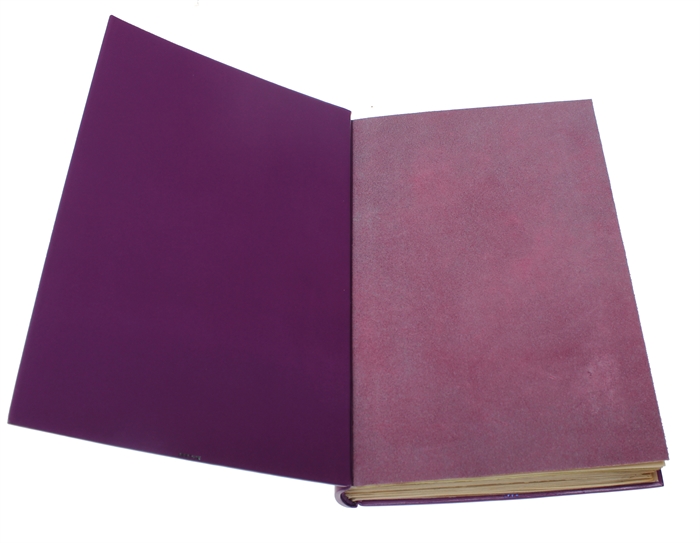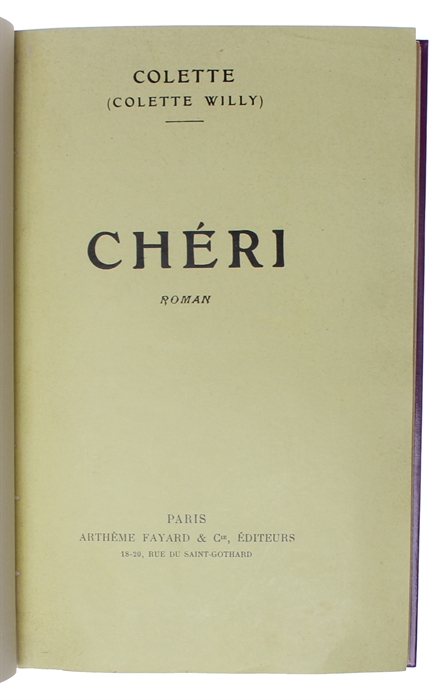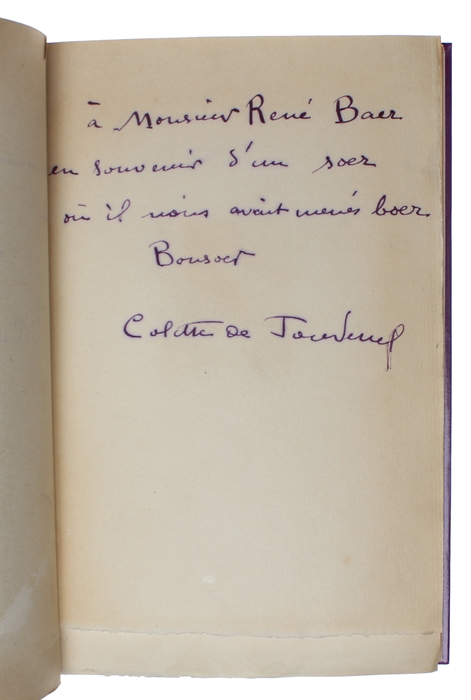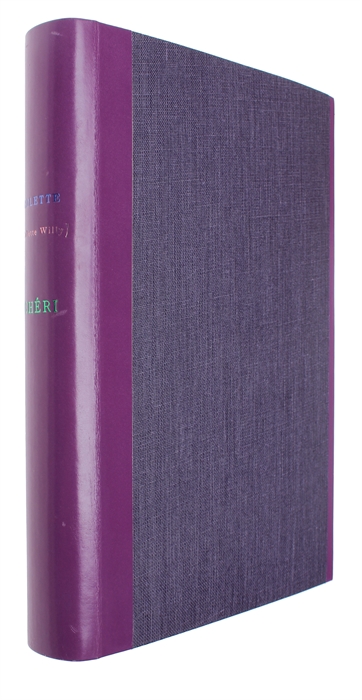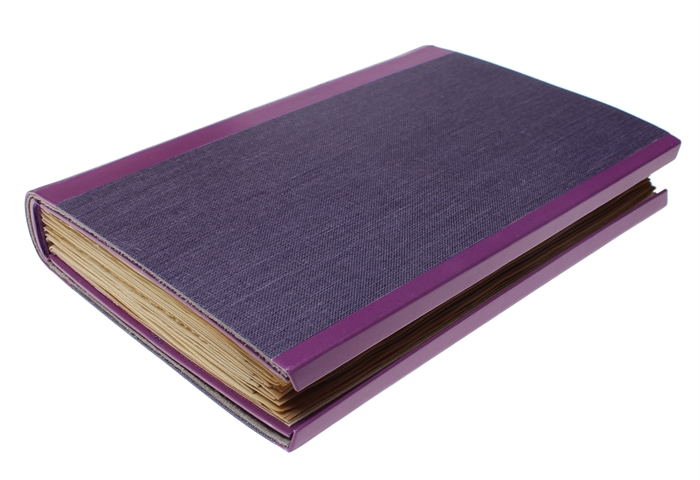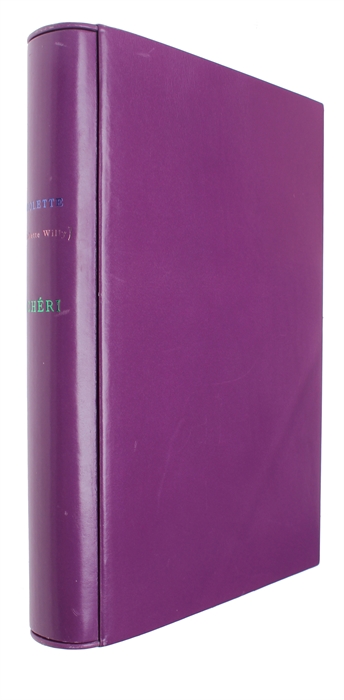PRESENTATION-COPY - ON OF 175 NUMBERED COPIES
COLETTE (COLETTE WILLY) [COLETTE de JOUVENEL].
Chéri. Roman.
Paris, 1920.
Bound uncut with the original printed wrappers, also the backstrip, in a magnificent bright purple lambskin binding with title and author in bright, metallic lettering to spine, blue, pink, and green respectively. Triple bright metallic line-borders to boards (same three colours), inside which the remainder of the boards are covered with a large inlay of shiny, coloured leather in crocodile skin-like relief pattern. Recto and verso respectively of flyleaves covered with pink/purple suede. Housed in a chemise with purple lambskin spine with same lettering as the binding and purple cloth boards, inside grey suede, and purple full lambskin slipcase. The binding is signed Leroux (in shiny green lettering to inside of front board). A handwriiten postcard from Leroux to the previous owner of the book is enclosed. The postcard is dated 1997 and concerns the binding, including the price. The slipcase has a bit of edgewear, but the binding is near mint. Apert from a tiny tear (no loss) to the upper margin of the front wrapper, also internally near mint.
Front free end-paper with a four-line inscription for "René Baer" signed "Colette de Jouvenel".
First edition - presentation-copy and one of 175 numbered copies on Hollande (premier papier), out of a total of 725 numbered copies - of Colette's fascinating novel "Chéri", published at the dawn of the roaring 20'ies. The scandalous novel, which portrays the love between an older woman and a much younger man, is partly inspired by Colette's own life, and is considered one of her very best works. Extremely controversial as a person, Colette has always been the object of fascination as well as controversy. In 1893, she married Henry Gauthier-Villars, who was already a famous author and publisher. He used the pen-name "Willy", under which Colette's famous first novels, the Claudine-stories, also appeared. Colette and Willy separated in 1906, with a final divorce in 1910. Colette is well known for the series of lesbian relationships she embarked upon after her separation. In 1912, however, she married Henry de Jouvenel, editor of Le Matin, and took his name. Not for her publications, but she clearly used it in her personal correspondence. Their marriage ended in divorce in 1924, however, due partly to her affair with her 16-year-old stepson, Bertrand de Jouvenel. Chéri is partly based upon her experiences with her much younger stepson. " 'Me a feminist?' She scoffed in 1910. 'I'll tell you what the suffragettes deserve: the whip and the harem'. COLETTE is an intriguing and flamboyant figure. Born in Burgundy in 1873 she moved to Paris at the age of twenty with her husband the writer and critic Henry Gauthiers-Viller (Willy). Forcing Colette to write, Willy published her novels in his name and the Claudine series became an instant success. She escaped her exploitative first husband to live by her pen and work in music-halls as a dancer. Colette had a lesbian love affair with a niece of Napoleon's, she married three times, had a baby at 40 and at 47, preferring 'passion to goodness', she seduced her teenage stepson. In the meantime she wrote stunning novels that were admired by Proust and Gide -- Gigi, Sido, Cheri, and Break of Day. Colette lived to be over 80. She was the first woman President of the Academie Goncourt and was the first woman in France to be accorded a state funeral." "Colette, in full Sidonie-Gabrielle Colette, (1873 - 1954), outstanding French writer of the first half of the 20th century whose best novels, largely concerned with the pains and pleasures of love, are remarkable for their command of sensual description. Her greatest strength as a writer is an exact sensory evocation of sounds, smells, tastes, textures, and colours of her world. Georges Leroux (1922-1999) was one of the most accomplished and esteemed French binders of the twentieth century. Before he became a book binder, in 1959, he was a poet. His works are known for their exotic materials, use of metallic effects and strong polychromatic color.
Her best work was produced after 1920 and followed two veins. The first vein followed the lives of the slightly depraved, postwar younger generation. Among these novels are Chéri (1920) and La Fin de Chéri (1926; The Last of Chéri), dealing with a liaison between a young man (Chéri) and an older woman... (Encycl. Britt.).
René Baer (1887 - 1962) was a famous French author, journalist, playwright, and songwriter.
Order-nr.: 60344


